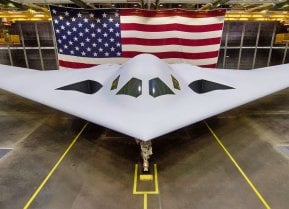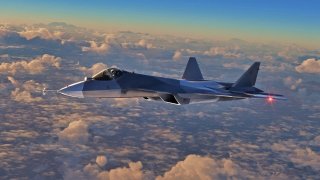Russia's Su-57 Felon: Badass Stealth Fighter or a Sad Joke?
The Russian United Aircraft Corporation announced a significant increase in state defense orders for the Su-57 Felon, a fifth-generation stealth fighter, with plans for heightened production in 2024.
Summary: The Russian United Aircraft Corporation announced a significant increase in state defense orders for the Su-57 Felon, a fifth-generation stealth fighter, with plans for heightened production in 2024. Despite its advanced design and stealth capabilities, the Su-57's deployment and effectiveness have been questioned, particularly due to its limited use in Ukraine. The aircraft, boasting cutting-edge technology and potential for further advancement, faces skepticism regarding its stealth capabilities and combat effectiveness against Western counterparts. This has led to doubts about Russia's ability to produce the aircraft in significant numbers, despite claims of its superiority and innovative features.
Russia's Su-57 Felon Back in the Spotlight
The head of the Russian United Aircraft Corporation claimed on Tuesday that state defense orders for the Kremlin's Su-57 Felon fifth-generation stealth fighter increased by a factor of two in 2023.
"We have completed the state defense order. Everything stipulated by signed contracts and time schedules was delivered in time, even in advance for certain plants," Yury Slyusar, CEO of the state-owned UAC told the Rossiya-24 TV Channel, per a report from TASS. "Concerning new airplanes, the order for the Su-57 aircraft has increased almost twofold. The order is even greater and even more work will have to be done in 2024."
However, Slyusar stopped short of actually saying how many Sukhoi Su-57 (NATO reporting name "Felon") aircraft were actually produced.
Even before Russia launched its unprovoked invasion of Ukraine nearly two years ago, Moscow had struggled with the production of the Su-57. The program experienced a protracted development due to various structural and technical issues that emerged during trials, including the destruction of the first production aircraft in a crash before its delivery.
The Kremlin has repeatedly suggested that upwards of 76 Su-57s could be delivered to the Russian Aerospace Forces by 2027, yet, to date, fewer than two dozen have been delivered.
Su-57 Felon: Its Capabilities Have Been Questioned
The Su-57 has been noted for being the first Russian-built aircraft to feature stealth technology. At the same time, it further served as a test bed for the basis of a family of stealth-based aerial combat systems that could include unmanned aerial systems (UAS).
Yet, it has largely been absent from the skies over Ukraine. Moscow clearly doesn't want the bad press that comes with losing such a weapon in combat – and as a result the aircraft has only been employed in sorties where it launched missiles into Ukraine while "safely" over the skies of Russia.
The aircraft was developed by the Sukhoi Design Bureau within United Aircraft (UAC), part of the state-owned defense conglomerate Rostec. It was seen as a momentous leap forward in Russian aircraft design. As a "fifth-generation" aircraft – a marketing term introduced by Lockheed Martin to tout its F-35 Lightning II – the Russian warbird was noted for combining the functions of an attack aircraft with a fighter jet. It was touted to be able to engage and destroy various land, airborne, and maritime targets.
The Kremlin also boosted that it employed composite materials including polymer, fiberglass, and aluminum load-bearing honeycomb fillers. It also featured an aerodynamic configuration that includes a pair of internal weapons bays, which help provide a low level of radar and infrared signature.
Each of the aforementioned bays was designed to carry up to four K-77M beyond visual range radar-guided missions. In addition, the Su-57 can carry a pair of K-74M2 short-range infrared-guided missiles in underwing fairings, but at the expense of its stealth.

According to Air Force Technology, the aircraft is also equipped with 3D thrust vector jets for higher maneuverability and is capable of developing supersonic cruising speed. The twin-engine fighter is powered by Izdeliye 117 or AL-41F1 augmented turbofans, and it can fly at a speed of up to Mach two without afterburners, while it can reach a range of up to 3,500km at subsonic speeds.
The aircraft has been further noted to employ a powerful onboard computer – which has been described as an electronic second pilot – while its radar system is spread across its body. Its onboard avionics systems include active electronically scanned array (AESA) radar and ELINT systems.
On paper at least, the Su-57 is an impressive aircraft.
Russia has further suggested that an upgraded and even more advanced model of the Su-57 could be in the works and that it would be the world's first in-service "sixth-generation" aircraft.
This was first noted in a November 2017 report from Russian state media outlet Tass, which cited Russian Aerospace Force ex-commander and Chairman of the Federation Council Defense and Security Committee Viktor Bondarev, who explained, "This is actually a splendid plane and it can embrace both fifth-and sixth-generation features. It has huge modernization potential. Importantly, it is the best among the existing versions by its stealth characteristics. It incorporates all the best that is available in modern aviation science both in Russia and in the world."
Yet, even as Russia has continued to tout the aircraft, a multiple number of Western aviation experts have suggested the Su-57 is all hype – and that Moscow lacks the manufacturing capabilities even to produce the aircraft in significant numbers. That has been noted by the fact that the Su-57 first flew in January 2010 but didn't enter service until December 2020.
Aviation expert Chris Bolton noted on social media last year, "Russia's Su-57 'stealth' fighter has a radar cross-section comparable to clean F/A-18 Super Hornet and around a thousand times bigger than F-35. Russia's fleet of Felons consists of 12 hand-made prototypes with varying degrees of finish and just two production jets…"

Other experts have also questioned whether the Felon could truly be described as a stealth aircraft, and suggested in a head-to-head fight, the Su-57 would be hopelessly outclassed when going up against the Lockheed Martin F-35. The Russian fighter has a design that is much closer to an advanced fourth-generation fighter than a true fifth-generation aircraft. It may be less detectable than an F-15 Eagle or F-16 Fighting Falcon, but it simply has poor cross-section compared to its main fifth-generation rivals.
Those facts could explain why the Kremlin hasn't deployed it over the skies of Ukraine, instead, its combat role has been primarily to fire weapons from within the safety of Russian airspace. Clearly, Russian officials don't believe its stealth is good enough to send over enemy territory.
Author Experience and Expertise
Peter Suciu is a Michigan-based writer. He has contributed to more than four dozen magazines, newspapers, and websites with over 3,200 published pieces over a twenty-year career in journalism. He regularly writes about military hardware, firearms history, cybersecurity, politics, and international affairs. Peter is also a Contributing Writer for Forbes and Clearance Jobs. You can follow him on Twitter: @PeterSuciu.
All images are Shutterstock.


